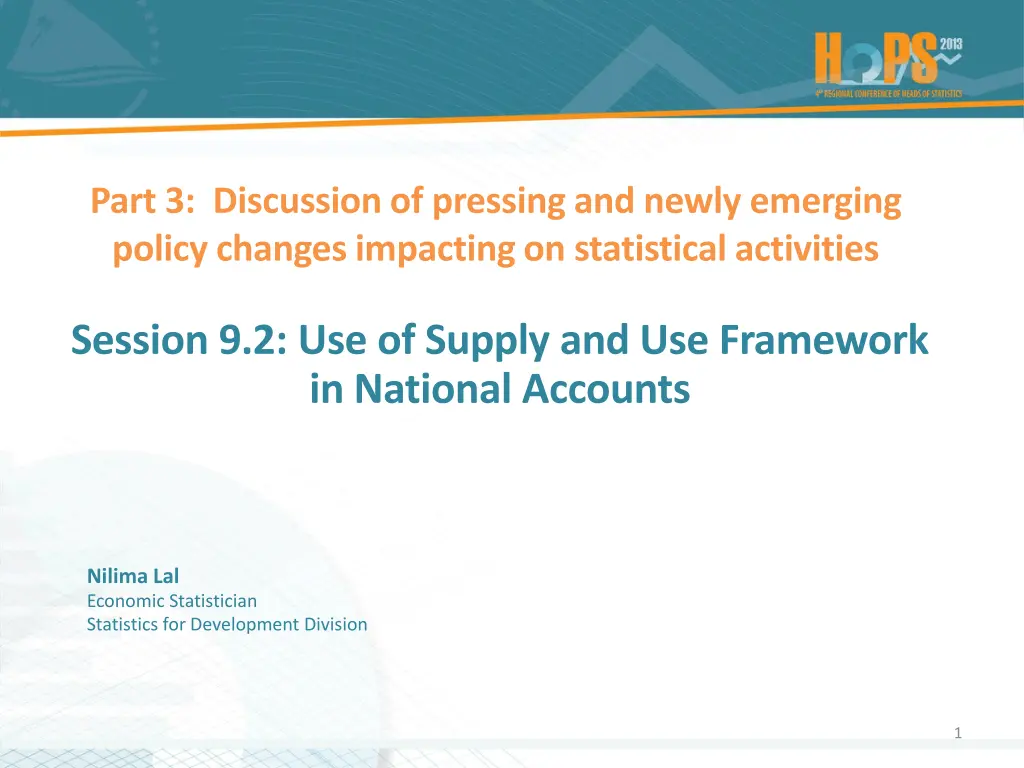
Discussion on Supply and Use Framework in National Accounts
Learn about the implementation and importance of the Supply and Use Framework in national accounts, including its role in providing reliable GDP estimates and facilitating informed decision-making. Explore the achievements, challenges, and current initiatives in this area, such as technical assistance to countries like Fiji for SUT compilation.
Download Presentation

Please find below an Image/Link to download the presentation.
The content on the website is provided AS IS for your information and personal use only. It may not be sold, licensed, or shared on other websites without obtaining consent from the author. If you encounter any issues during the download, it is possible that the publisher has removed the file from their server.
You are allowed to download the files provided on this website for personal or commercial use, subject to the condition that they are used lawfully. All files are the property of their respective owners.
The content on the website is provided AS IS for your information and personal use only. It may not be sold, licensed, or shared on other websites without obtaining consent from the author.
E N D
Presentation Transcript
Part 3: Discussion of pressing and newly emerging policy changes impacting on statistical activities Session 9.2: Use of Supply and Use Framework in National Accounts Nilima Lal Economic Statistician Statistics for Development Division 1
USE OF SUPPLY AND USE FRAMEWORK IN NATIONAL ACCOUNTS Background Pacific Statistics Strategy Action Plan, Phase 1 (2011 2014) recommends regular production of national accounts including implementation of 2008 SNA standards as PICTs No. 1 priority in economic statistics: System of National Accounts (SNA) requires countries to construct Supply and Use Table (SUT): reconciled GDP estimates more reliable, consistent and internationally comparable better basis for measuring economic output and growth and lead to informed decision/policymaking 2
USE OF SUPPLY AND USE FRAMEWORK IN NATIONAL ACCOUNTS Background cont.. The principle SUTs are based on are: products available for use in a country are either domestically produced or imported = total supply the total supply are used for intermediate consumption, final consumption expenditure, capital formation and exports. A simplified SUT is given below: 3
[1] SUPPLY AND USE TABLE SUPPLY USE Final consumption expenditure Capital formation Goods and services Intermediate consumption Government Total supply institutions Gross fixed households inventories Non-profit Production Household formation Change in Domestic Total use Imports serving Exports capital Fish Canned fish Health services Total Value Added Quadrant of the Supply and Use Table Gross value added Compensation of employees Consumption of fixed capital Taxes less subsidies Gross operating surplus/Mixed income Domestic production less value added 4
USE OF SUPPLY AND USE FRAMEWORK IN NATIONAL ACCOUNTS Achievements/Highlights Currently SPC is providing technical assistance to Fiji, which is the only country in the Region compiling a SUT. Integrated GDP compilation Confrontation of data Identification of data gaps Consistency of supply and use at commodity level Valuation adjustments Efficient way to incorporate all basic data inconsistency 5
USE OF SUPPLY AND USE FRAMEWORK IN NATIONAL ACCOUNTS Major challenges 1. Demand for detailed product level data 2. Technical skills of compilers 3. Resources 1. Manpower 2. Financial 6
USE OF SUPPLY AND USE FRAMEWORK IN NATIONAL ACCOUNTS Way forward SPC should work with PICTS desirous of compiling a SUT in a phased-out approach: a) review what data/systems countries have b) do classification correspondence tables c) develop gross output and the intermediate consumption matrix, d) develop final demand matrix and imports vector, e) do valuation vectors, f) balance SUT, g) develop uses of the value added quadrant, h) finalize SUT. 7
USE OF SUPPLY AND USE FRAMEWORK IN NATIONAL ACCOUNTS Recommendation HOPS is invited to recommend to countries to consider strengthening their compilation of source data ((also refer to SPC/HOPS 2013/Working Paper 2-4.2 on International Merchandise Trade Statistics in PICTs and SPC/HOPS 2013/Working Paper 2-4.3 on Progress of work on Business Statistics in PICTs) and use a phased out approach to compile SUT. 8
